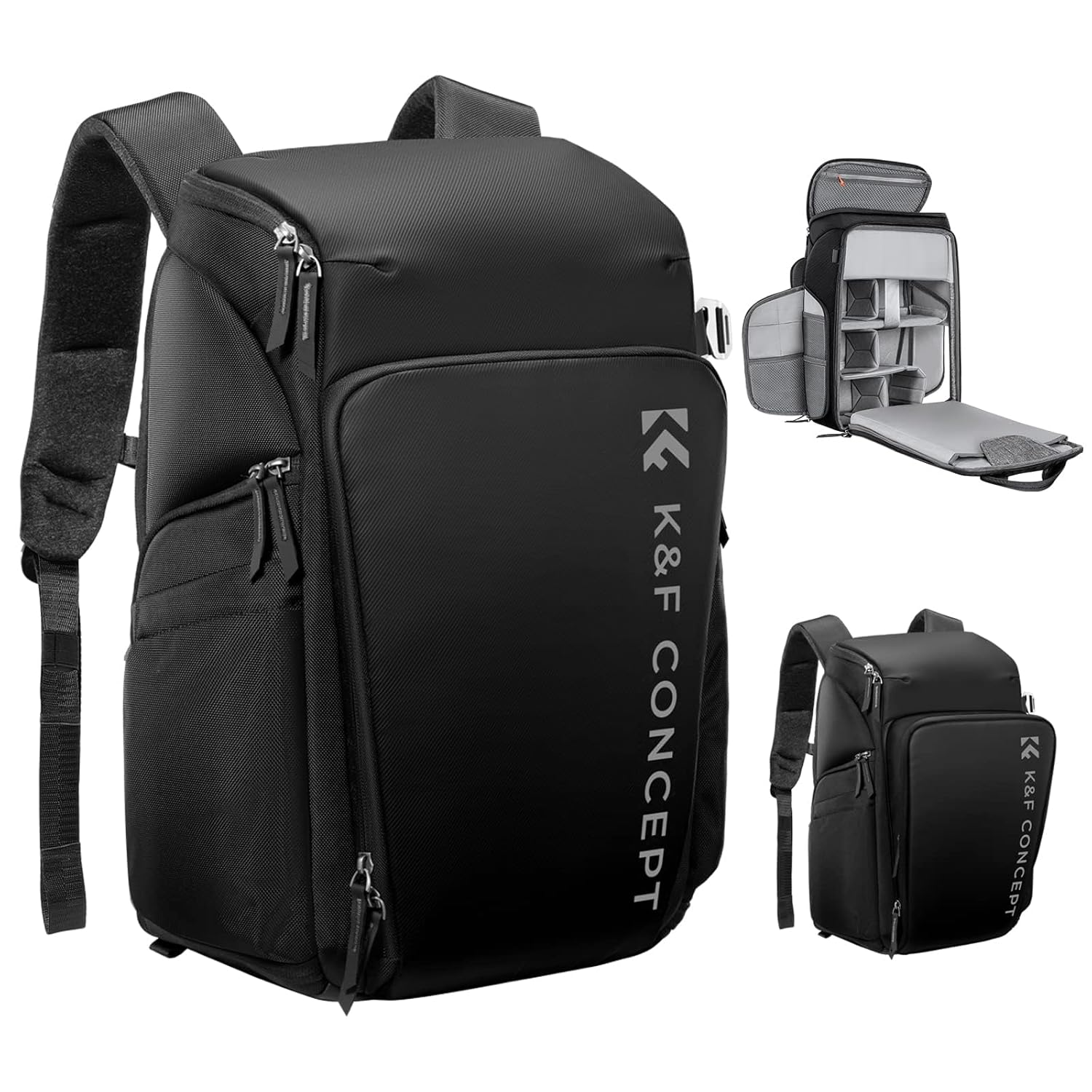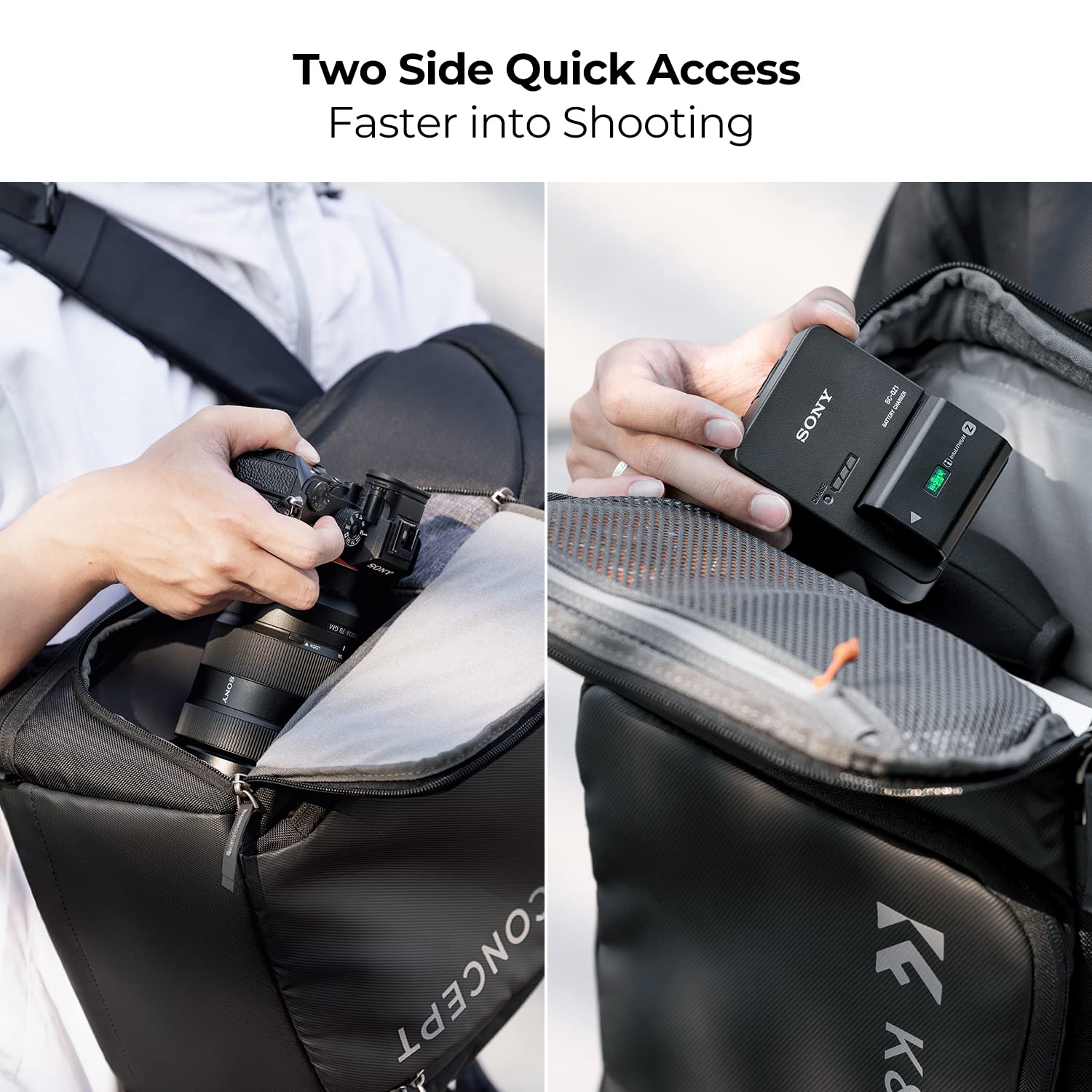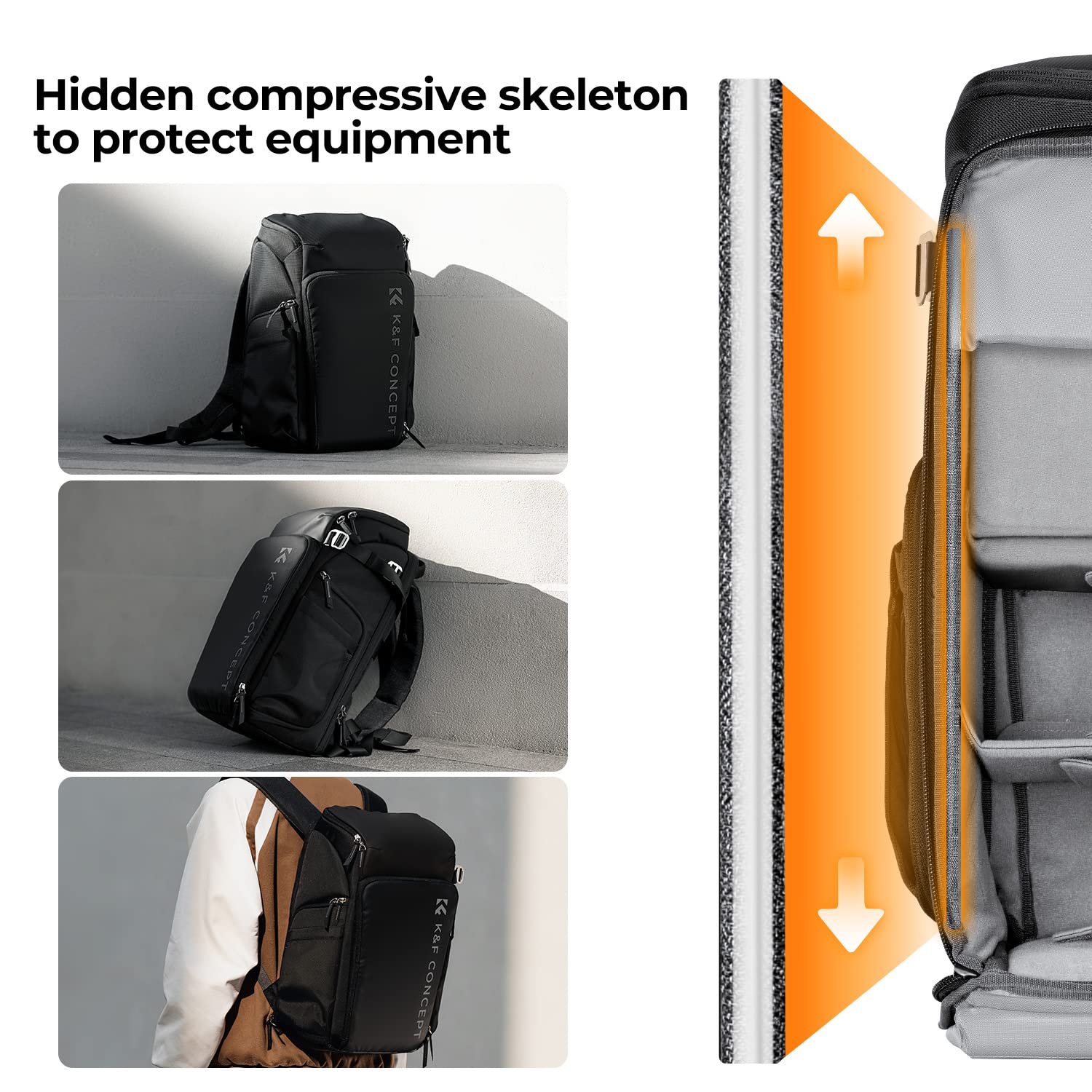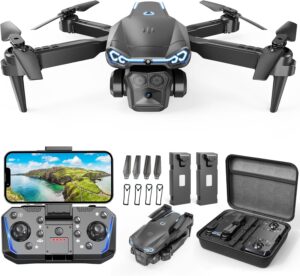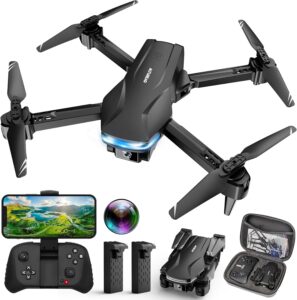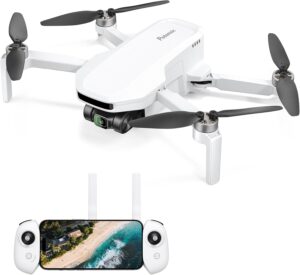Are we the only ones who measure our weekends not in hours but in how many lenses we can carry without aging ten years in the shoulders?
Why This Particular Camera Backpack Pulled Us In
We’ve owned bags that promised to be everything to everyone and then tapped out the minute we carried a second body or a laptop that wasn’t on a juice cleanse. The K&F Concept Camera bags Waterproof 25L Large Capacity Camera Case with Raincover Camera Case 15.6 Inch Laptop Compartment Compatible with Canon/Nikon/Sony/DJI Mavic Drone Travel Camera Backpack announced itself with a mouthful of a name and a handful of genuinely useful ideas. We were curious, then we started packing it, and then we did that quiet nod we reserve for things that actually work.
Two big reasons stood out instantly. First, the Magic Chamber design—an adjustable internal divider system that shifts the interior from a 50:50 split to a 20:80 split—means we get to choose the bag’s personality each day. Second, it has an independently accessible laptop compartment (rated up to a professional 16-inch device within precise dimensions of 360×260×20 mm) that doesn’t rub shoulders with our camera gear. No awkward cohabitation in there; it’s more “polite neighbors who wave from the driveway.”
K&F Concept Camera bags Waterproof 25L Large Capacity Camera Case with Raincover Camera Case 15.6 Inch Laptop Compartment Compatible with Canon/Nikon/Sony/DJI Mavic Drone Travel Camera Backpack
Design and Build Quality
We judge bags on two levels: how they feel when they’re empty and how they behave when we fill them to the emotional weight of a Sunday evening. This backpack feels thoughtfully engineered before a single battery goes inside. Hidden support fibers are integrated to keep equipment from being compressed by external pressure, and that structure also gives the bag better stability when we plunk it down. It’s sturdier and less slouchy than most, which we appreciate, because we’ve met too many camera bags that crumple like a papier-mâché project.
The overall shape feels tidy for a 25L pack, and it carries with a reassuring, quiet confidence. The materials read as weather-ready, and the included rain cover has that “we hope we never need it, but we’re relieved it’s there” vibe. There’s nothing flashy or gimmicky. It’s practical, with just enough cleverness to make us smile instead of squint.
The Magic Chamber: Our Adjustable Attic
The headlining act is the Magic Chamber system. Inside, the main cavity can be pushed or pulled to reconfigure the proportions. In its neutral mode, we get a 50:50 layout—half for camera compartments, half for personal items or overflow gear. With a few adjustments, it becomes a 20:80 layout, freeing up a large single space for a chunky kit or a jacket, snacks, and that tripod mount we swear we put somewhere sensible.
We’ve used adjustable interiors before, but this is one of the few that genuinely reshapes the bag, not merely shuffles dividers. It’s ideal when our day swings from a portrait session (lots of optics, fewer snacks) to a travel day (one body, a prime lens, a sweater, and a book we’ll optimistically pretend to read).
Two Independent Camera Compartments with Top and Side Access
We often want the opposing virtues of speed and order. This bag lets us have both. There are two separate camera compartments that we can access from the top or the side. That means we can keep a primary camera body in the top for quick access and stash a second body or a drone kit in the side compartment, equally quick to reach when we need it. The dual-door concept reduces the dreaded mid-shoot rummage where we look like we’re unpacking for a month in the middle of a sidewalk.
In practice, this setup saved us during a wedding when we needed a 35mm lens immediately for the first dance. We swung the bag off one shoulder, unzipped the side, and there it was, smiling up at us like it had rehearsed.
Front Pouch Expansion: A Sneaky 2–3 Liters
We’ve learned that accessories multiply like rabbits. The front pouch on this backpack expands by up to 2–3 liters, giving us a little breathing room when the cable pouch gains six cousins and a tripod plate appears from thin air. This compartment is independent from the main camera chambers, which provides extra stability for sensitive gear. Batteries and chargers appreciate the separation. So do we.
Laptop Compartment That Keeps Its Distance
The laptop area is independently padded and sized for slim professional machines up to 16 inches, with a maximum precise dimension of 360×260×20 mm (14.17″×10.2″×0.78″). For most 15.6-inch laptops and many 16-inch models, that’s a snug, reassuring fit. If you lug a thick gaming laptop, measure carefully. We love that our computer doesn’t press directly against our cameras and lenses—it’s the backpack version of keeping the soup and salad on different plates.
Hidden Support Fibers and Ground Stability
Our gear has been in bags that collapsed like soufflé after a car door bumped them. Here, the hidden support fibers add a quiet spine. They help resist compression from outside pressure and keep the silhouette crisp, which makes loading easier and protects lenses from surprise squeezes. The design also steadies the bag when we set it down, minimizing the dreaded sideways flop that sends us reaching out like we’re rescuing a toddler. We’ve placed this bag on polished floors and grass alike, and it stayed composed.
Weather Readiness and the Rain Cover
The product is marketed as waterproof and includes a rain cover for truly foul weather. In our rainy-day tests, the combination kept our gear dry. We prefer having both a weather-resistant shell and a dedicated cover because storms are dramatic, and so are we. The cover bundles down small in the bag, adding minimal weight for maximum peace of mind.
Capacity and Layout: 25 Liters Used the Smart Way
A bag’s liters can be an optimistic suggestion if the layout wastes space. This 25L backpack uses its volume thoughtfully. The twin camera compartments help us compartmentalize (literally and emotionally), while the Magic Chamber lets us reclaim space for personal items when needed. The independent accessory compartment keeps a steady core for fragile kit, and the expandable front pocket gives us a pressure valve when the day grows chaotic.
We’ve found we can carry a camera body (Canon, Nikon, or Sony) with a midrange zoom mounted, plus a couple of extra lenses, a DJI Mavic drone with controller, a day’s worth of batteries and filters, and our slim laptop—without feeling like the bag swallowed our weekend plans. The structure helps the load sit comfortably and prevents a “bag of laundry” appearance.
Example Loadouts That Worked for Us
We pack differently for different jobs, and this backpack has handled the variety. A few real-world loadouts:
-
Portrait Day:
- Top compartment: Full-frame body with 24–70mm attached, 85mm prime, two spare batteries, lens cloth, circular polarizer.
- Side compartment: Flash, wireless trigger, compact reflector, small diffuser.
- Front expansion pouch: Charger, extra batteries, cable bag.
- Laptop sleeve: 15.6-inch ultrabook (within 360×260×20 mm).
-
Travel and Street Photography:
- Top compartment: Mirrorless body with 35mm prime, 24–105mm zoom, small pouch with cards and ND filters.
- Side compartment: DJI Mavic drone, controller, spare props, one battery.
- Magic Chamber shifted toward 20:80 to free more space for a lightweight jacket and snacks.
- Front expansion pouch: Power bank, charging cables, compact umbrella.
- Laptop sleeve: 16-inch thin-and-light within the stated size limits.
-
Hybrid Video Day:
- Top compartment: Mirrorless body with cage (minimal), 24–70mm, shotgun mic, small LED panel.
- Side compartment: Audio recorder, lav kit, batteries, mini tripod head.
- Front expansion pouch: External SSD, HDMI cable, cable ties, gaffer tape (the emotional support item of video work).
- Laptop sleeve: 15-inch slim laptop.
We like that we can shift between these profiles without rethinking the whole bag. The ease of reshaping the interior keeps us moving instead of fiddling.
Everyday Use and Quick Access
We used to avoid certain shots because digging for gear in a crowded bag felt like going to the DMV during our lunch break. The top and side quick-access design changed our behavior. We now keep our most-used body and lens on the top, with the side set up for the next-likeliest options. It’s a small shift with a big payoff: fewer missed moments, less zipper drama, and fewer prayers whispered to the gods of Velcro.
The dual access also means we can stage gear more deliberately. We’ve taken to placing our “urgent” kit in one bay and our “nice to have” kit in another. It’s like giving ourselves a hierarchy without feeling bossy.
Organization That Doesn’t Ask For a Spreadsheet
Some camera bags assume we love fiddly compartments the way some people love spreadsheets. We don’t. We like organization that’s obvious and doesn’t punish us for being human on a long day. The K&F Concept backpack’s layout feels approachable. Dividers are intuitive, the separate accessory compartment keeps odd-shaped things tamed, and the front expansion pouch forgives last-minute additions.
We found ourselves cleaning less often because the bag encourages zones—this pocket for tech, that bay for optics, laptop over there, and so on. Less cross-contamination means fewer mystery scratches and a heart rate that stays normal.
Comfort and Carry
We care about straps, padding, and how the bag sits against our spine. This pack carries like it was built by someone who knows that photographers walk far and get weirdly weighed down by glass and batteries. The structure distributes weight evenly, and the supported shape resists sagging, reducing that lopsided pull that leads to shoulder regret.
Even fully loaded, it remained manageable for city walks and transit hops. We found the balance reassuring when hustling up stairs or wedging into a train. The improved ground stability is a bonus—set it down to switch lenses and the bag doesn’t topple like a tipsy penguin.
Durability in the Real World
A bag has to survive more than scheduled use. It needs to handle being overstuffed, shoved under cafe tables, and tossed into the backseat while we wonder if we left the batteries charging in the kitchen. The hidden support fibers help protect the structure and gear during those less-than-gentle moments. The seams and zippers behaved well in our hands, and the material shrugged off a few scuffs that would have scarred softer fabrics.
We’re also fond of the 1-year extra service offered with each bag. We treat it like a safety net: rarely needed, comforting to know it’s there.
The Laptop Situation, Revisited
We’re repeating ourselves because laptops are fractious creatures. The compartment is independent, padded, and sized for machines up to 360×260×20 mm. In plain terms, most 15.6-inch notebooks and many 16-inch ultrabooks will fit. If your device is thicker than 20 mm, treat this as a heads-up to measure. We appreciate the bright-line dimension—it’s the kind of precision that saves us from heartbreak on the day we fly across the country.
The separation from camera equipment is perhaps our favorite detail, because we’ve seen what happens when a metal edge meets a delicate LCD at the wrong moment. This layout avoids that unwanted introduction.
Weather and Workdays
We’re based in a place where the forecast enjoys a plot twist. On one drizzly shoot, we pulled the rain cover over the pack and watched the water bead and slide away. Everything inside remained dry and emotionally stable. We prefer carrying the cover even when the sky looks honest; it’s light insurance against a sudden turn.
Between the water resistance of the bag itself and the dedicated cover, we felt confident carrying an extra lens we’d otherwise leave at home. We do love a weather scenario in which nothing dramatic happens.
Who This Backpack Suits Best
We never met a one-size-fits-all camera bag. We have met one-size-fits-many. This is that bag. It shines for:
- Photographers who alternate between lean kits and heavy days.
- Hybrid shooters who carry a mix of optics, audio, and small lights.
- Travelers who want a single pack for camera gear plus a laptop and personal items.
- Drone pilots who need a separate bay for a DJI Mavic and controller.
- Commuting creatives who want a tidy look with sudden capacity on tap.
If you need a rigid, hard-case experience or you’re packing cinema bodies and giant cine glass, this might not be your only bag. For everyone else, it’s a practical daily driver with good manners.
Tips for Packing and Setup
This backpack rewards small habits. A few ideas we learned the pleasant way:
- Set your quick-access plan: top for your most-used body and lens, side for secondary gear.
- Use the Magic Chamber actively. If your day is mostly personal items with a bit of kit, shift to a 20:80 distribution and enjoy the space.
- Keep chargers and power banks in the front expansion pouch so they don’t wander into fragile territory.
- Place heavier lenses closer to your back and lower in the bag to keep the center of gravity friendly.
- Respect the laptop dimensions. If you’re near 20 mm thick, consider a thinner sleeve or verify exact specs.
- Stash the rain cover where you can reach it during a sudden sprinkle. You’ll feel clever later.
Feature Breakdown at a Glance
We like a snapshot of the essentials. Here’s how this backpack stacks up in the ways that count to us.
| Feature | What It Is | Why It Matters |
|---|---|---|
| Capacity | 25 liters | Room for a camera kit, drone, accessories, plus laptop and daily items. |
| Magic Chamber | Adjustable interior shifting from 50:50 to 20:80 | Tailors the bag’s layout to the day’s loadout. |
| Dual Compartments | Two separate camera chambers | Keeps gear organized and reduces rummaging. |
| Access Points | Quick access from top and side | Faster gear changes and fewer missed moments. |
| Laptop Sleeve | Independent compartment up to 360×260×20 mm (approx. 15.6″ and many 16″) | Protects computer and keeps it separate from camera gear. |
| Front Expansion | Pouch expands by 2–3 liters | Swallows extra accessories without crowding fragile items. |
| Protection | Hidden support fibers to resist compression | Safeguards optics and stabilizes the bag on the ground. |
| Weather | Marketed as waterproof with included rain cover | Added confidence in unpredictable weather. |
| Compatibility | Built for Canon, Nikon, Sony; fits DJI Mavic drone setups | Works with common camera systems and popular drones. |
| Service | 1-year extra service | A bit of peace of mind for frequent users. |
Real-World Scenarios Where It Earned Its Keep
We keep a mental scrapbook of moments when a bag helps or hinders. A few that stick:
-
The “City Hop” Day: Two shoots, two neighborhoods, one backpack. We ran lean: body with 24–70mm, a prime, drone, laptop, and microphone. Top-access saved us from the dreaded bag-on-sidewalk sprawl between appointments. The bag stood up neatly while we swapped batteries, saving us from performing the lens ballet in public.
-
The “Family Visit That Became a Shoot”: We brought a low-key kit for a weekend away and got asked—surprise!—to do photos at a cousin’s engagement party. Shifting to a 20:80 layout made room for clothes and a small gift while keeping the side compartment ready for a flash and two lenses. We were ready without feeling like a pack mule.
-
The “Rain-and-Run” Afternoon: Sudden downpour during street photography. Rain cover on, problem over. Our bag was less drama than the weather app.
Pros and Cons
We try to be even-handed. This bag has personality and strengths, and a few tradeoffs to note.
Pros:
- Flexible interior that actually changes how we pack, not just how we shuffle.
- Two independent camera compartments with quick access from top and side.
- Independent laptop compartment with real-world dimensions clearly stated.
- Hidden support fibers that keep structure intact and gear protected.
- Front pouch expansion delivers small but meaningful extra capacity.
- Included rain cover and weather-ready construction.
- Stands more confidently on the ground than many soft backpacks.
- Compatible with major camera brands and DJI Mavic drones.
Cons:
- The laptop slot favors thin machines; thicker laptops may not fit the 20 mm depth limit.
- If you prefer a single large, open main cavity at all times, the dual-compartment concept requires a little retraining.
- At 25L, it’s roomy for most daily uses, but if you carry cinema rigs or long telephotos regularly, you may want a second, larger specialized case.
Comparing It to Other Bag Types We’ve Used
We have a closet that looks like a support group for camera bags. Here’s how this one sits among the usual suspects:
-
Versus a Sling: Slings are lightning-fast but max out quickly. This K&F Concept backpack is almost as quick thanks to top and side access, with far more capacity and comfort for daylong carries.
-
Versus a Classic Photo Backpack: Many traditional photo packs are either rigid and heavy or soft and saggy. This bag threads the needle with a structured feel without dead weight, thanks to the support fibers and thoughtful compartments.
-
Versus a Rolling Case: Rollers are great for airports and flat surfaces. We don’t love them on stairs, cobblestones, or grass. For mixed terrain and public transport, this backpack feels freer and easier.
-
Versus a Tote/Messenger: Stylish but shoulder-heavy and disaster-prone in weather. The K&F Concept pack won’t win a fashion week, but it wins on balance, weather readiness, and gear protection.
Little Touches That Add Up
We notice small things after a few weeks that we don’t see on day one. The way the zippers move without sounding like we’re opening a suitcase from 1972. The layout that discourages stacking filters on top of lenses (and then pretending we planned it that way). The sense that we don’t have to fight the bag to make it work; it’s on our side, which is all we ask of inanimate objects.
We also appreciate that the backpack manages to be professional without screaming “thousands of dollars inside.” It blends in. It’s the quiet friend who knows the train schedule and always has gum.
Travel Friendliness
We’ve taken it through transit with the ease of a seasoned commuter. At 25 liters, it fits neatly in overheads and under seats on most airlines, and the laptop slot makes security less theatrical. The independent camera compartments allowed us to keep the sensitive stuff stable while we pulled out the computer and chargers at checkpoints. Once we arrived, it doubled as a daypack without feeling out of place.
We also liked that expanding the front pouch at the destination gave us a little extra capacity for souvenirs (read: coffee beans and a magnet shaped like a lobster).
Maintenance and Care
Bags are like shoes—ignore them and they’ll squeak at you. Our maintenance routine:
- Brush off dust and grit after outdoor shoots. Grit is the enemy of zippers.
- Air it out if it meets a rainstorm, even if the contents stayed dry.
- Keep the rain cover accessible but dry it before stowing when it’s wet.
- Don’t overstuff beyond the structure’s kind limits; the hidden support fibers are strong, but they’re not magical unicorn beams.
Do this and the bag will keep treating your gear with respect.
Common Questions We Had (And Answered by Using It)
-
Will our 16-inch laptop fit? If it’s within 360×260×20 mm, yes. Many 15.6-inch and slim 16-inch machines do. If your laptop is thicker, you’re on a measurement tightrope—check carefully.
-
Can it house both a camera kit and a DJI Mavic? Yes. We’ve comfortably carried a mirrorless kit and a Mavic with controller. The dual compartments help keep them from squabbling.
-
Is it really quick to access both compartments? Yes. The top and side accesses aren’t just marketing; they’re practical and easy to use mid-stride.
-
Does it stand up on its own? More than most backpacks we’ve tested. The reinforced structure and hidden support fibers reduce the classic bag topple.
-
How weather-ready is it? The bag is marketed as waterproof and comes with a rain cover. Together, they kept our gear dry in rainy conditions.
-
What about the warranty? It includes 1-year extra service on each bag, which is a reassuring safety blanket.
The Intangible Stuff: How It Changes Our Day
Some bags nag us. They rustle, slump, and require a series of small accommodations. This one goes quiet once we put it on. We think less about the bag and more about the shoot. We stop negotiating with ourselves about which lens to leave behind. We’re less likely to miss a fleeting moment because a zipper got shy.
It’s also nice when a bag supports our better habits. The double access prods us to stage our kit smartly. The Magic Chamber nudges us to configure for the day’s reality instead of forcing yesterday’s layout into today’s job. The independent laptop compartment respects boundaries in a way that would make a therapist proud.
If We Could Change One or Two Things
We’d include a small tag inside the laptop sleeve with the maximum device dimensions for quick reference. We know the numbers by heart now, but on a busy morning, it’s nice to have an in-bag reminder. And while the 25L capacity is excellent for daily work, some of us occasionally want a bigger sibling for long telephotos or stabilizers. That’s less a flaw and more a wish list item for a companion model.
Bottom Line: The Bag We Keep Reaching For
We own too many camera bags, and still, this is the one we keep grabbing because it doesn’t ask us to compromise. The K&F Concept Camera bags Waterproof 25L Large Capacity Camera Case with Raincover Camera Case 15.6 Inch Laptop Compartment Compatible with Canon/Nikon/Sony/DJI Mavic Drone Travel Camera Backpack marries flexible space with quick access and thoughtful protection. It respects the gear we carry and the ways we actually work, right down to the laptop that gets its own quiet place to live.
We appreciate products that solve real problems without showboating. This backpack strikes that balance with its adjustable Magic Chamber, dual independent compartments, front pouch expansion, and that ever-comforting rain cover. If you shoot with Canon, Nikon, or Sony, travel with a DJI Mavic, or simply want a camera backpack that adapts to the varied mess of creative life, this one fits the brief.
We’ll keep using it for shoots that run from morning portraits to late-night edits, for flights that promise smooth skies and deliver drama, and for days when we can’t decide whether to bring the drone until the last possible moment. It’s good to have a bag that says, “Either way, we’ve got space.” And on the busiest days, when time and weather both misbehave, it’s even better to have a bag that stays upright, keeps its shape, and gets us to the shot without fuss.
Disclosure: As an Amazon Associate, I earn from qualifying purchases.
